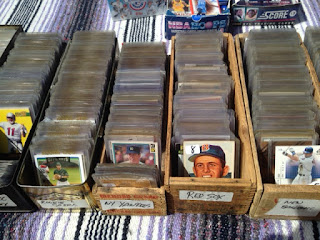One of my Vineyard visitors.
I had never heard of Nelson Chittum, who went 3-0 with a sterling 1.19 ERA for the 1959 Red Sox. Then I met him yesterday, along with Carl Yastrzemski and Bill Lee.
Each summer I pack up my lucky 2004 SUV with the Red Sox/Jimmy Fund license plates and drive/ferry my family to Martha's Vineyard for a last gasp of summer before Labor Day. Michelle loves reading and letting her mind unwind from the daily challenge of helping her patients recover from strokes and brain injuries; Jason and Rachel, now 14 and 11, enjoy the final unstructured days before school.
Me? I love the trip back in time.
The beaches and bike trains and Ben and Bills ice cream are all great, but my favorite moment of each year's journey may be the first few minutes Jason and I spend rifling through the baseball cards at the Chillmark Flea Market. They are split up into beat-up boxes marked "1950-60s" "1970s-80s" and "Red Sox." and we fly through them all -- putting aside those "possibles" we will consider for purchase.
Little stickers in the top right corner of each card's protective plastic sleeve tell us what it will set us back, and Jason knows I'm seldom going to spend more than $5 for any given card. It's not Honus Wagner I'm after here, but a few moments of my childhood -- and Jason's.
Before my eyes, my son has quickly become a full-fledged teenager. He grew about 8 inches in the last 8 months, and his voice dropped from tenor to bass. His body is filling out, taking him from the "before" photo in the old Charles Atlas ad much closer to the "after." He recovered from major leg and hip surgery in February faster than anyone expected, and spoke in front of 1,500 students and family members as his middle-school salutatorian in June.
Jason, before time took over.
In two weeks he will be a freshman at Newton North High, my alma mater, and plans to join the wrestling team and the theater program. Other than the three or four games we go to together at Fenway each year, baseball is very far from his mind. I've tried rekindling his interest, but he'd rather talk about movies, music, or even politics than the Red Sox pitching rotation. I'm slowly accepting it.
For those couple minutes at the flea market, however, both of us are 8 year-olds enthusiastically mining for gold. Ken Goldberg, who owns the cards along with a treasure-trove of road signs, books, and other items, stands back and watches. I am sure he has seen this countless times before -- fathers, sons, and the occasional mom and daughter thumbing back through the decades.
I collected baseball cards feverishly through my grade-school days, picking up most of them at Garbs drugstore by the Boston College trolley stop. Friends -- Greg Rutan and Kim Myers most spring to mind -- would accompany me on these trips, and we'd look over our loot while devouring ice cream sundaes next door at Brigham's. We'd always hope for Red Sox, of course, and barring that a star like Munson or Palmer or Foster.
Ken helps bring me back.
It was the same with me and Jason when he was a little kid. We'd haunt the few remaining baseball card stores left in the Metro West area, and split our time buying new packs and looking through oldies. He devoured baseball history books and covered his walls with posters of Big Papi, Ted Williams, Hank Greenberg, and (of course) Jason Varitek.
 Then, one by one, the stores starting closing, reflecting a generation of kids that was moving increasingly online or onto "faster" sports like basketball and football. My son's interest waned along with the public's; he was a mediocre ballplayer, like his old man, and probably stayed in Little League one year longer than he wanted to for my sake.
Then, one by one, the stores starting closing, reflecting a generation of kids that was moving increasingly online or onto "faster" sports like basketball and football. My son's interest waned along with the public's; he was a mediocre ballplayer, like his old man, and probably stayed in Little League one year longer than he wanted to for my sake.Now Jason is a self-professed nerd who spends his time writing and playing intricate online computer games with friends all over the world. The posters and books in his room are changing along with his interests. My nephew is the baseball star; Jason is the star of Katan.
Until we get in front of Ken's table.
"Look -- a '75 Yaz!" Jason yells, at the same moment I pull out my 1960 Nelson Chittum (I'm a sucker for any card with that old smiling Red Sock logo). A confident-looking 1978 Bill Lee -- that summer, I remind Jason, would not turn out well for him or the team -- comes out next.
He spots a '65 Tony Conigliaro, where the 20-year-old stares out at the camera with a steely resolve. The card is bent and faded, giving it no real value, but Jason knows better: this is Tony C. in all his young, handsome glory, before the Gods of Fate beat him down.
Forever young.


















